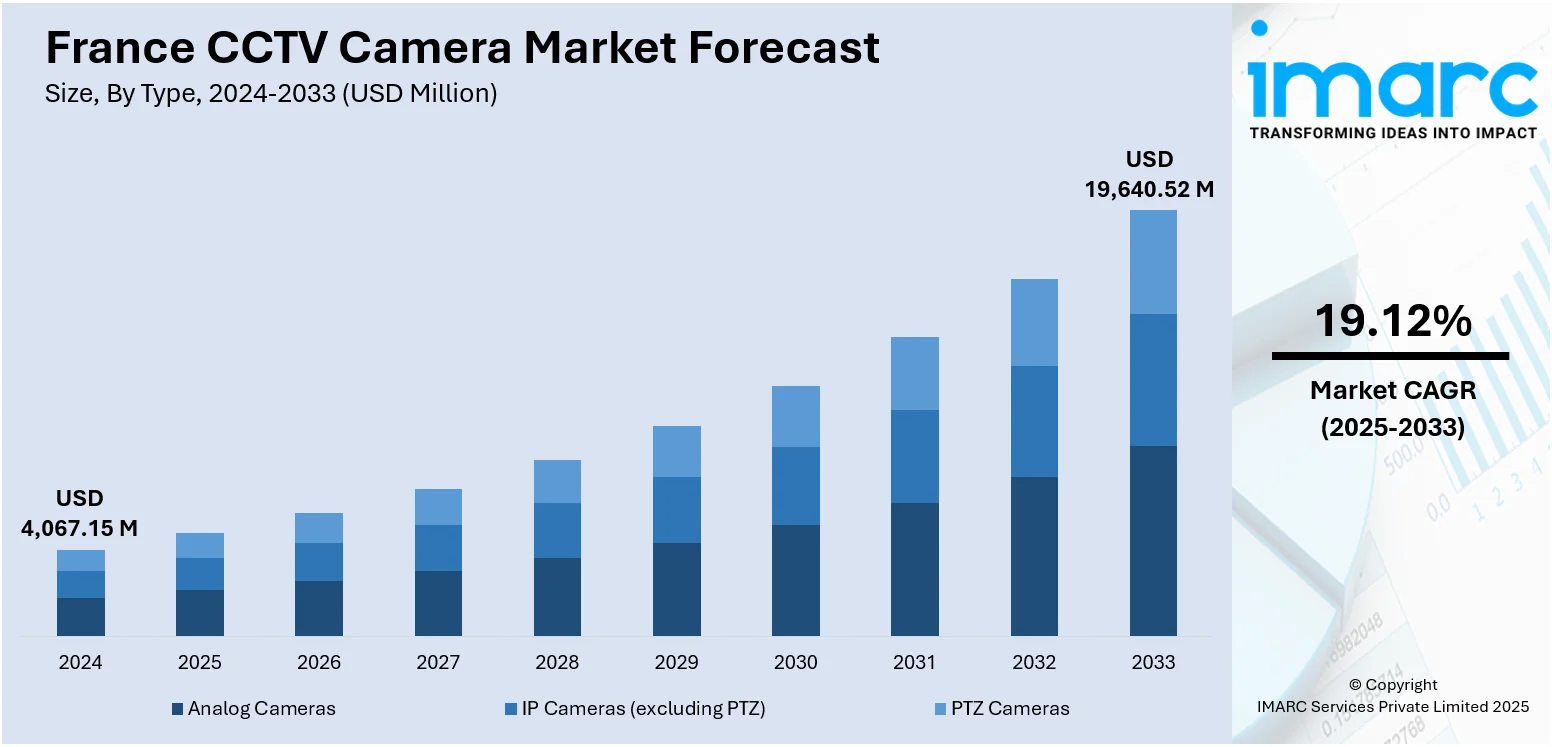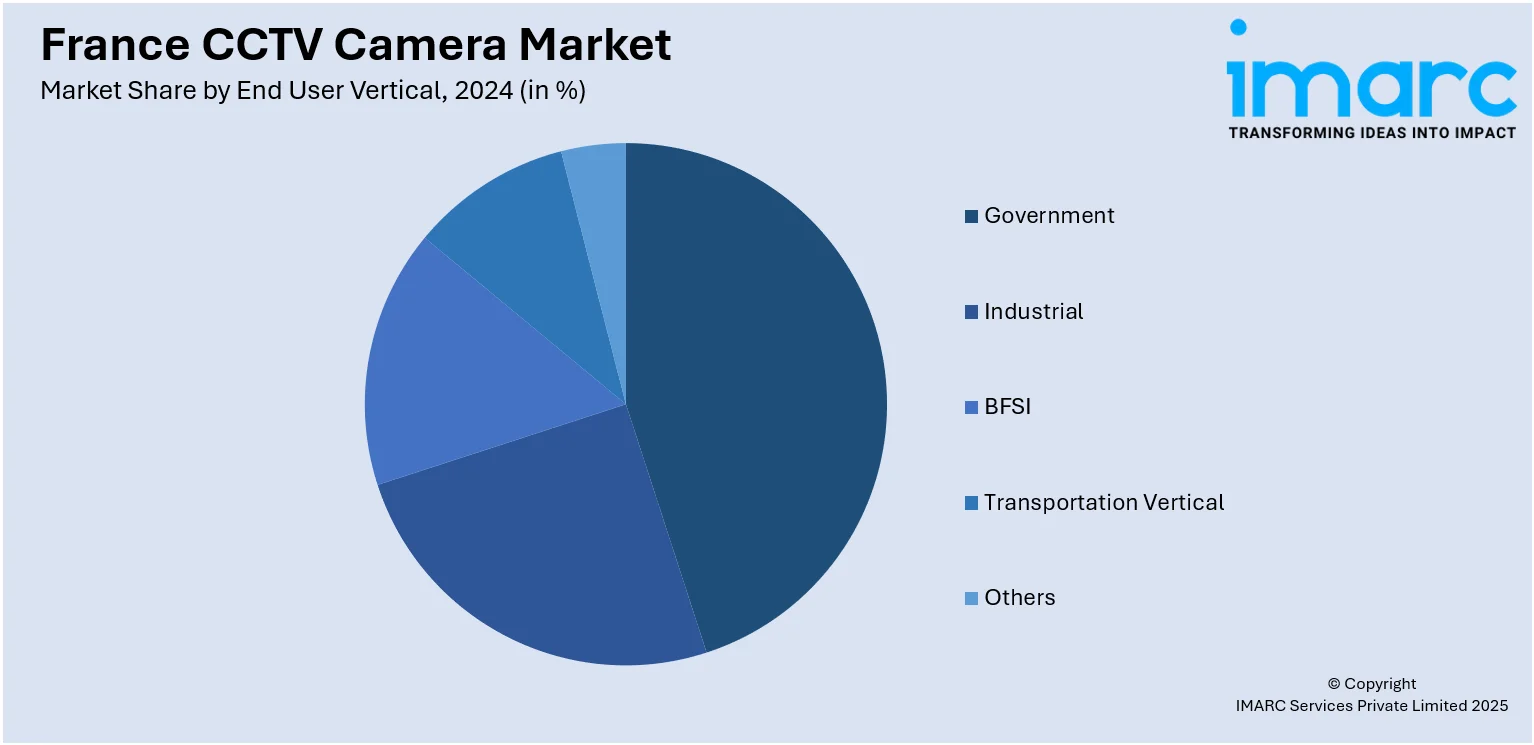
France CCTV Camera Market Size, Share, Trends and Forecast by Type, End User Vertical, and Region, 2025-2033
France CCTV Camera Market Overview:
The France CCTV camera market size reached USD 4,067.15 Million in 2024. Looking forward, the market is projected to reach USD 19,640.52 Million by 2033, exhibiting a growth rate (CAGR) of 19.12% during 2025-2033. The market is experiencing steady growth, supported by rising security concerns, urban infrastructure development, and the adoption of advanced surveillance technologies. Demand is increasing across public, commercial, and industrial sectors, with a shift toward IP-based and AI-integrated systems. Government initiatives to strengthen national security are further boosting CCTV installations across smart cities and transport hubs, contributing to the projected expansion of France CCTV camera market share in the coming years.
|
Report Attribute
|
Key Statistics
|
|---|---|
|
Base Year
|
2024
|
|
Forecast Years
|
2025-2033
|
|
Historical Years
|
2019-2024
|
| Market Size in 2024 | USD 4,067.15 Million |
| Market Forecast in 2033 | USD 19,640.52 Million |
| Market Growth Rate 2025-2033 | 19.12% |
France CCTV Camera Market Trends:
Increased Use of AI and Analytics
The rising integration of AI and advanced analytics is significantly contributing to the growth of the CCTV market in France. Contemporary surveillance systems now come with intelligent features such as facial recognition, license plate identification, object tracking, and behavioral analysis. These technologies facilitate real-time threat detection, which aids in prompt and informed responses to potential security issues. AI-based CCTV systems are particularly beneficial in densely populated areas such as transportation hubs, government facilities, and commercial districts, where manual monitoring could be impractical. By automating the identification of suspicious activities, these innovations lessen the dependence on human oversight and enhance the overall efficacy of security systems. Additionally, AI functionalities are increasingly being utilized for non-security purposes like traffic flow optimization and customer behavior analysis, further broadening their applications. For instance, the 2024 Paris Olympics featured extensive AI-powered surveillance to enhance security, with the French government collaborating with tech companies to deploy advanced monitoring systems. Critics warn this could normalize widespread state surveillance, raising significant privacy and legal concerns amid a climate of heightened security risks surrounding major public events. These advancements are playing a vital role in the continued growth of the France CCTV market growth trajectory.

To get more information on this market, Request Sample
Smart City Projects Driving Demand
The incorporation of surveillance technology into smart city projects is greatly impacting the France CCTV market. As cities upgrade their infrastructure, there is an increasing focus on utilizing intelligent surveillance systems for traffic management, public space monitoring, and ensuring the safety of citizens. CCTV cameras are being installed at intersections, transit hubs, and public facilities as part of a comprehensive urban management approach. For instance, in November 2024, France announced its plans to enhance traffic safety with AI-powered cameras capable of detecting mobile phone use, seatbelt violations, and more. The initiative aims to modernize existing surveillance and is expected to generate additional fines, raising concerns over potential wrongful penalties and privacy as surveillance expands beyond the Paris Olympics. These systems, when integrated with real-time data analytics and IoT platforms, equip city officials with valuable insights to enhance traffic flow, swiftly identify incidents, and respond more effectively to emergencies. Furthermore, smart surveillance plays a role in urban planning by studying crowd dynamics and public behavior. With government support and heightened investment in smart city initiatives throughout France, the demand for sophisticated CCTV systems is anticipated to grow, establishing surveillance as a crucial aspect of forward-looking urban development strategies.
France CCTV Camera Market Segmentation:
IMARC Group provides an analysis of the key trends in each segment of the market, along with forecasts at the country and regional levels for 2025-2033. Our report has categorized the market based on type and end user vertical.
Type Insights:
- Analog Cameras
- IP Cameras (excluding PTZ)
- PTZ Cameras
The report has provided a detailed breakup and analysis of the market based on the type. This includes analog cameras, IP cameras (excluding PTZ), and PTZ cameras.
End User Vertical Insights:

- Government
- Industrial
- BFSI
- Transportation Vertical
- Others
A detailed breakup and analysis of the market based on the end user vertical have also been provided in the report. This includes government, industrial, BFSI, transportation vertical, and others.
Regional Insights:
- Paris Region
- Auvergne-Rhône-Alpes
- Nouvelle-Aquitaine
- Hauts-de-France
- Occitanie
- Provence-Alpes-Côte d’Azur
- Grand Est
- Others
The report has also provided a comprehensive analysis of all the major regional markets, which include Paris Region, Auvergne-Rhône-Alpes, Nouvelle-Aquitaine, Hauts-de-France, Occitanie, Provence-Alpes-Côte d’Azur, Grand Est, and others.
Competitive Landscape:
The market research report has also provided a comprehensive analysis of the competitive landscape. Competitive analysis such as market structure, key player positioning, top winning strategies, competitive dashboard, and company evaluation quadrant has been covered in the report. Also, detailed profiles of all major companies have been provided.
France CCTV Camera Market Report Coverage:
| Report Features | Details |
|---|---|
| Base Year of the Analysis | 2024 |
| Historical Period | 2019-2024 |
| Forecast Period | 2025-2033 |
| Units | Million USD |
| Scope of the Report |
Exploration of Historical Trends and Market Outlook, Industry Catalysts and Challenges, Segment-Wise Historical and Future Market Assessment:
|
| Types Covered | Analog Cameras, IP Cameras (excluding PTZ), PTZ Cameras |
| End User Verticals Covered | Government, Industrial, BFSI, Transportation Vertical, Others |
| Regions Covered | Paris Region, Auvergne-Rhône-Alpes, Nouvelle-Aquitaine, Hauts-de-France, Occitanie, Provence-Alpes-Côte d’Azur, Grand Est, Others |
| Customization Scope | 10% Free Customization |
| Post-Sale Analyst Support | 10-12 Weeks |
| Delivery Format | PDF and Excel through Email (We can also provide the editable version of the report in PPT/Word format on special request) |
Key Questions Answered in This Report:
- How has the France CCTV camera market performed so far and how will it perform in the coming years?
- What is the breakup of the France CCTV camera market on the basis of type?
- What is the breakup of the France CCTV camera market on the basis of end user vertical?
- What is the breakup of the France CCTV camera market on the basis of region?
- What are the various stages in the value chain of the France CCTV camera market?
- What are the key driving factors and challenges in the France CCTV camera market?
- What is the structure of the France CCTV camera market and who are the key players?
- What is the degree of competition in the France CCTV camera market?
Key Benefits for Stakeholders:
- IMARC’s industry report offers a comprehensive quantitative analysis of various market segments, historical and current market trends, market forecasts, and dynamics of the France CCTV camera market from 2019-2033.
- The research report provides the latest information on the market drivers, challenges, and opportunities in the France CCTV camera market.
- Porter's five forces analysis assist stakeholders in assessing the impact of new entrants, competitive rivalry, supplier power, buyer power, and the threat of substitution. It helps stakeholders to analyze the level of competition within the France CCTV camera industry and its attractiveness.
- Competitive landscape allows stakeholders to understand their competitive environment and provides an insight into the current positions of key players in the market.
Need more help?
- Speak to our experienced analysts for insights on the current market scenarios.
- Include additional segments and countries to customize the report as per your requirement.
- Gain an unparalleled competitive advantage in your domain by understanding how to utilize the report and positively impacting your operations and revenue.
- For further assistance, please connect with our analysts.
 Request Customization
Request Customization
 Speak to an Analyst
Speak to an Analyst
 Request Brochure
Request Brochure
 Inquire Before Buying
Inquire Before Buying




.webp)




.webp)












